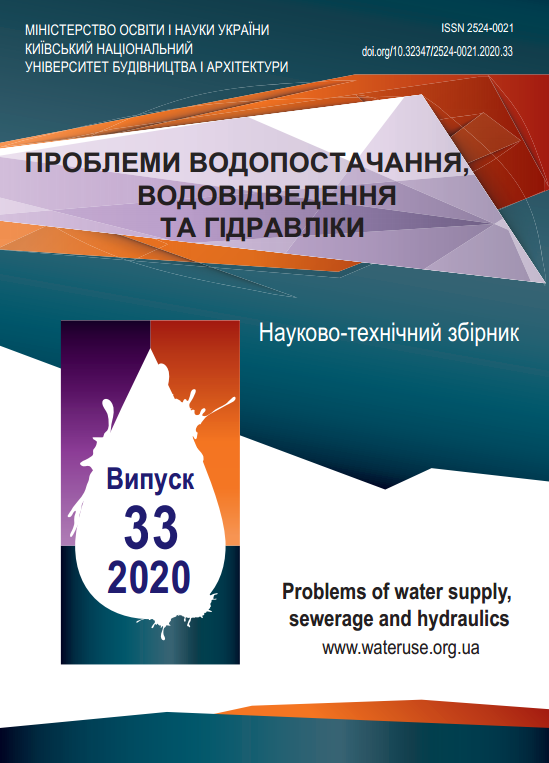Biotechnology complex treatment of multi-component groundwater
DOI:
https://doi.org/10.32347/2524-0021.2020.33.26-33Ключові слова:
ferrobacteria, matrix structures of bio-minerals, bioreactor, biotechnology, groundwaterАнотація
Groundwater is a complex multicomponent system characterized by the content of heavy metal ions, organic compounds, humic acids, dissolved gases, inorganic compounds (NH4+, NO2-, NO3-), phenols, phosphates. Most of the existing groundwater treatment plants in Ukraine were put into operation in the mid-1970th using simplified aeration filtration technology, which did not provide for the comprehensive removal of these contaminants.
The aim of the work is to analyze modern technologies based on the biochemical method of groundwater treatment, selection of rational values of environmental parameters required for growth and development of the world's most common groups of ferrobacteria, as well as identifying mechanisms of complex biological groundwater treatment of iron and ammonium compounds, nitrogen, dissolved organic matter contained in such waters, in the contact loading of bioreactors.
The paper presents an analytical review of existing biological deironing stations put into operation in different countries. The types of iron bacteria and characteristics of their natural environments are given. The general characteristic of the offered biotechnology of complex purification of multicomponent underground waters is given. The mechanisms of formation of the matrix structure of bio-minerals in the interporous space of the contact loading of the bioreactor and the mechanisms of removal of organic and mineral compounds of iron, ammonium nitrogen, dissolved organic compounds in the treatment of weakly acidic, neutral and near groundwater are considered.Посилання
Kvartenko, O. M., & Sablij, L. A. (2017). Researches of operating the station treating multi-component underground waters in conditions of changing hydraulic loadings. Problems of Water supply, Sewerage and Hydraulic, 28, 170-176. [in Ukrainian]
Kvartenko, A., Orlov, V., & Pletuk, O. (2017). Research into the biosorption process of heavy metal ions by the sediments from stations of biological iron removal. Eastern-European Journal of Enterprise Technologies, 4(10(88)), 37-43. doi:10.15587/1729-4061.2017.106961
Tanimoto, K. (1952). Suido Kyokai Zasshi, J. Japan Water Works Assoc., 213, 19-21.
Mouchet, P. (1992). From Conventional to Biological Removal of Iron and Manganese in France. Journal of the American Water Works Association, 84(4), 158-167.
Hettler, J. P. (1982). Une Station de Defferrisation Biologiqui. TSN – L'Eau.
Cameron, I., & Bourgine, F. (1999). New frontier – biological iron and manganese removal from drinking water. Paper presented at International Congress on Local Government Engineering and Public Works: Incorporating the 10th National Local Government Engineering Conference, Sydney, Australia.
Mouchet P. (1995). Biological Filtration for Iron and Manganese Removal: Some Case Studies. Paper presented at WQTC 95 (AWWA) New Orleans LA.
Fujikawa Y., Sugahara M., Hamasaki T., Yoneda D., Minami A., Sugimoto Y., & Iwasaki H. (2010). Biological filtration using iron bacteria for simultaneous removal of arsenic, iron, manganese and ammonia: Application to waterworks facilities in Japan and developing countries. J. Human Environ. Studies. 9, 261-276.
Askerniia, A. A., Sorokina, A. Iu., & Dubinina, G. A. (2014). Microbiological aspects of natural underground water deironing and demanganation. Vodosnabzhenie i Sanitarnaia Tekhnika, 12, 14-21.
Zhurba, M. G., Govorova, Zh. M., Kvartenko, A. N., & Govorov, O. B. (2006). Biochemical deironing and demanganation of underground water. Vodosnabzhenie i Sanitarnaia Tekhnika, 9(2), 17-23.
Dubinina, G. A. (1977). Biologiya zhelezobakterij i ikh rol` v obrazovanii zhelezo-marganczevy`kh rud [Biology of iron bacteria and their role in the formation of iron-manganese ores] (Extended abstract of Doctor's thesis). Moscow. [in Russian]
Tropina, E. A. (2007). Apparaturno-tekhnologicheskaya sistema polucheniya pit`evoj vody` iz podzemny`kh istochnikov Zapadno-Sibirskogo regiona [Apparatus and technological system for obtaining drinking water from underground sources of the West Siberian region] (Candidate's thesis). Tomskij politekhnicheskij uni`versitet, Tomsk [in Russian]
Kvartenko, O., Gryuk, I., & Sabliy, L. (2017). Model of biomineralization of ferrum compounds by Gallionella cells immobilized on contact loading of bioreactor. Energy Engineering and Control Systems, 3(2), 51-56. doi:10.23939/jeecs2017.02.051
Deng, Y., & Englehardt, J. D. (2006). Treatment of landfill leachate by the Fenton process. Water Research, 40(20), 3683-3694. doi:10.1016/j.watres.2006.08.009
Lodha, B., & Sanjeev, C. (2007). Optimization of Fenton-biological treatment scheme for the treatment of aqueous dye solutions. Journal of Hazardous Materials, 148(1-2), 459-466. doi:10.1016/j.jhazmat.2007.02.061
Du Toit, G., Blignaut, H., Theunissen, B., & Briggs, J. (2014). Biological filtration for sustainable treatment of groundwater with high iron content – a case study. Water SA.
Kvartenko, O., Sabliy, L., Kovalchuk, N., & Lysytsya, A. (2018). The use of the biological method for treating iron containing underground waters. Journal of Water and Land Development, 39(1), 77-82. doi:10.2478/jwld-2018-0061
##submission.downloads##
Опубліковано
Як цитувати
Номер
Розділ
Ліцензія
Автори, які публікуються у цьому журналі, погоджуються з наступними умовами:
a) Автори залишають за собою право на авторство своєї роботи та передають журналу право першої публікації цієї роботи, яка через 70 років після смерті останнього співавтора з дати публікації автоматично стає доступною на умовах ліцензії Creative Commons Attribution License, котра дозволяє іншим особам вільно розповсюджувати опубліковану роботу з обов'язковим посиланням на авторів оригінальної роботи та першу публікацію роботи у цьому журналі.
b) Автори мають право укладати самостійні додаткові угоди щодо неексклюзивного розповсюдження роботи у тому вигляді, в якому вона була опублікована цим журналом (наприклад, розміщувати роботу в електронному сховищі установи або публікувати у складі монографії), за умови збереження посилання на першу публікацію роботи у цьому журналі.
c) Політика журналу дозволяє і заохочує розміщення авторами в мережі Інтернет (наприклад, у сховищах установ або на особистих веб-сайтах) рукопису роботи, як до подання цього рукопису до редакції, так і під час його редакційного опрацювання, оскільки це сприяє виникненню продуктивної наукової дискусії та позитивно позначається на оперативності та динаміці цитування опублікованої роботи (див. The Effect of Open Access).


